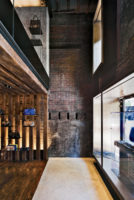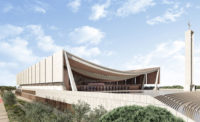Arario Gallery by Adjaye Associates
New York City
Architects & Firms
The growing reputation of David Adjaye has hinged on the London architect’s longtime relationship with the art world. He has accumulated studio commissions from artists Jake Chapman, Chris Ofili, and Lorna Simpson, and he installed Your Black Horizon at the Venice Biennale in 2005 with Olafur Eliasson. Adjaye’s extensive collaboration with Ofili includes the environment he designed for The Upper Room at the Tate Britain in 2007; Ofili, in turn, painted a wall mural in Adjaye’s Nobel Peace Center café in Oslo and created decorative glass for his new Stephen Lawrence Centre in London.
Another art-world link that Adjaye has forged is with Ci Kim, a renowned aficionado of Asian art and the founder of Arario Gallery. The two have been planning a private museum complex that will house Kim’s collection and will welcome visiting artists.
While Kim’s private cache of artworks has grown, his business has expanded even more rapidly. Launched from Cheonan, Korea, in 2002, Arario now comprises a network of additional galleries in Seoul, Beijing, and New York. When Kim learned that Adjaye had opened a New York office to facilitate completion of the Museum of Contemporary of Art Denver and to pursue further work in North America, he asked him to design a New York outpost for the gallery. Located in the white-hot West Chelsea arts district, it had a soft opening in November and officially launches this month.
Adjaye has mixed feelings about commercial assignments like Arario’s. “It’s a selling space, it’s a shop for art,” he says. But he agreed to Kim’s request, noting, “I’m interested in a way of bringing in another layer of richness—of public experience—to that private discourse.”
To design Arario Gallery New York, Adjaye drew on his artist connections and the places where they work. “It’s interesting to see the scale they choose,” he says of visiting artists’ studios. “Although it’s a kaleidoscope of spaces, it’s very precise—artists are slightly superstitious about their environment.” And although artists produce their work in these very characteristic studios, the final product “is neutralized when it comes into an institutional setting. I tried to bring back a relationship between art-making and art space, rather than follow an agenda of linear footage.”
Adjaye divided the 15,000-square-foot floor plate into reception, storage, and office spaces, as well as three galleries. The reception area forks into two main galleries, which run parallel to each other along an east-west axis. The southernmost gallery abuts an exterior wall, with a row of windows opening to the street below. Viewers proceed through the other, artificially illuminated space to a threshold that leads to the smaller gallery, devoted to emerging artists. The galleries evoke the scale of an artist’s studio, and that sense of domesticity is enhanced by the flooring choice of smoked oak. “There was an emphasis to not do neutral, abstracting concrete, but rather to use a material that has a specificity and warmth to it,” the architect says.
This shunning of the institutional atmosphere dovetailed nicely with the Arario Gallery’s existing condition. Located on the second floor of a turn-of-the-last-century storage depot—gallery director Jane Yoon recalls an initial walkthrough at which boxes were piled to the ceiling—Adjaye says the building features an “intense” column grid, which his walls partially hide. Exposed columns evoke even smaller, more intimate rooms within the gallery. They also intimate how the spaces may be further subdivided, a possibility made easier by a ceiling plane in which air ducts are hidden within rectilinear channels.
The way the gallery engages with its windows is another example of how Adjaye’s ideas about the ideal art experience have been reconciled with the existing space. Just as only two of the three galleries sit within plain view while the visitor discovers the third over time, the unobscured windows encourage making further discoveries—either of artworks or the surrounding neighborhood—at a leisurely pace. Whereas, as Adjaye says, “galleries have become soulless and generic,” Arario suggests a weekend trip to the home of Ci Kim or the studio of one of the artists he represents.




